
If you are planning to complete your H4 visa stamping at the U.S. Consulate in Toronto, this guide walks you through the process from start to finish. As an Indian citizen and Canadian Permanent Resident, I recently went through the same steps and documented the experience to help others know what to expect. While every case is unique, the general flow at the consulate is consistent, and understanding it in advance can make the appointment far less stressful.
📌 What is an H-4 Visa?
The H-4 visa is a dependent visa category for family members of individuals working in the United States on certain temporary work visas, most commonly the H-1B. It is available to spouses and unmarried children under 21 years of age of visa holders in the H-1B, H-1B1, H-2A, H-2B, or H-3 categories.
An H-4 visa allows dependents to legally reside in the U.S. for the same duration as the principal visa holder. H-4 dependents are also permitted to enroll in academic programs. In addition, some H-4 spouses may qualify for work authorization if the H-1B visa holder has reached certain stages in the U.S. green card process, such as being the beneficiary of an approved Form I-140 petition or receiving H-1B extensions under AC21.
✅ Quick Facts
-
Who qualifies? Spouses and unmarried children (under 21) of H-1B and other eligible visa holders.
-
Work eligibility? Only certain H-4 spouses, with approval for employment authorization.
-
Study eligibility? Yes, H-4 holders can pursue studies in the U.S.
Booking the Appointment
I first began looking for available appointments on June 3. At that time, there were no suitable dates, so I checked again later in the month. On June 22, I finally secured my first appointment, which was about two weeks out from the date I booked it. However, when I logged in again a couple of days later to monitor availability, I was able to reschedule to an earlier slot on June 13. This is one of the advantages of being a Canadian PR or citizen. The appointment availability is generally more flexible compared to what Third Country Nationals (TCNs) visiting Canada from abroad might experience, as they usually find available dates further out.
Preparing for the Appointment
For the stamping, I carried the following documents: my current passport along with any older passports, the DS-160 confirmation page, the appointment confirmation letter, my spouse’s I-797 approval notice, my marriage certificate, my Canadian PR card, copies of my spouse’s passport, visa, and I-94, and a set of recent passport photos.
Parking at the Consulate
I chose to drive to the appointment and parked in the lot located diagonally across the street from the consulate. This is the most convenient option in terms of proximity. The cost for the day was $20, as I opted for the full-day rate instead of the hourly rate. While the process ultimately took only about an hour and a half, I was glad to have paid the day rate so that I did not have to worry about the duration of my stay or about extending parking.
I also made sure to leave behind all electronics, including my phone and smartwatch, as these are not allowed inside the Toronto consulate. There are no locker facilities at the location, so it is best to leave your belongings securely in your hotel or car.
The Appointment Process
My appointment was scheduled for 10:30 a.m., but I arrived around 10:00 a.m. to line up outside. From the time I joined the first line to the moment I left the building, the process took approximately one and a half hours, and I was finished by 11:30 a.m. The Toronto consulate is typically busy, so some waiting is to be expected.
1. Initial Line Outside the Consulate
The process began outside the building, where a security guard reminded applicants not to carry electronics or smartwatches. We were also asked to keep the DS-160 confirmation page ready. At a small external window, staff checked my DS-160 page and appointment time before allowing me to proceed inside.
2. Security Screening
Inside the entrance, I placed my folder in a small basket for inspection and passed through a security scanner. After this screening, I was allowed through the second set of doors into the main waiting area.
3. Verification of Canadian Immigration Status
Once inside, two staff members checked my Canadian immigration status. Since I am a PR, I presented my PR card. Other applicants showed their visas or permits. Again, I was asked to provide my DS-160 confirmation page for verification.
4. Document Check and Photograph Review
At the first internal counter, my documents were checked in detail. The officer verified my photograph and supporting documents, including my spouse’s I-797 approval and the DS-160. One copy of my photograph was retained while the others were returned. The officer placed all my documents in a folder and instructed me to carry it forward for the interview.
5. Biometrics
The next step was biometrics. Since I had paid the MRV fee online in advance, I was able to proceed directly to fingerprinting and photo capture. Those who had not paid online were diverted first to the payment counter. For this reason, I highly recommend making the MRV payment online prior to your appointment.
6. The Visa Interview
The final step was the visa interview. At the interview window, I handed the prepared folder to the consular officer. The officer reviewed the documents while asking a few straightforward questions. I was asked where my spouse works, where he lives in the States, how long I typically stay when visiting the United States, and I was also requested to present my marriage certificate. The officer was professional, the questions were direct, and after a short review, I was informed that my visa had been approved.
Passport Delivery
After approval, my passport was retained by the consulate for stamping. Initially, I selected Canada Post pickup. However, after returning home, I decided to switch to home delivery, which required logging into the system again and paying an additional fee. While home delivery worked in my case, I would recommend that applicants consider Canada Post or BLS pickup if time is critical. Delivery to your home can take longer due to postal delays, especially during periods of strike activity.

Final Thoughts
In my experience, the H4 stamping process at the Toronto consulate was structured and efficient. All of the required steps like document verification, biometrics, and the interview, were completed within a single appointment. The consulate is a busy post, but the process moved in an orderly sequence, and having my documents prepared in advance helped everything proceed smoothly.
As a Canadian Permanent Resident, I also found that appointment availability was more flexible compared to what Third Country Nationals traveling from abroad typically encounter. By checking the scheduling system after I had already booked, I was able to secure an earlier date that had opened up. With preparation and awareness of how the process works, I found the H4 stamping in Toronto to be a manageable and straightforward experience.

This blog reflects my personal experience as an H-1B visa holder renewing in Canada. Visa policies, interview questions, and processing timelines can vary based on individual circumstances, U.S. consulate discretion, and changing immigration rules. For the most accurate and personalized guidance, please consult the official U.S. Department of State website or a licensed immigration attorney.
References
-
U.S. Citizenship and Immigration Services (USCIS): Employment Authorization for Certain H-4 Dependent Spouses
-
U.S. Department of State – Bureau of Consular Affairs: Temporary Worker Visas
